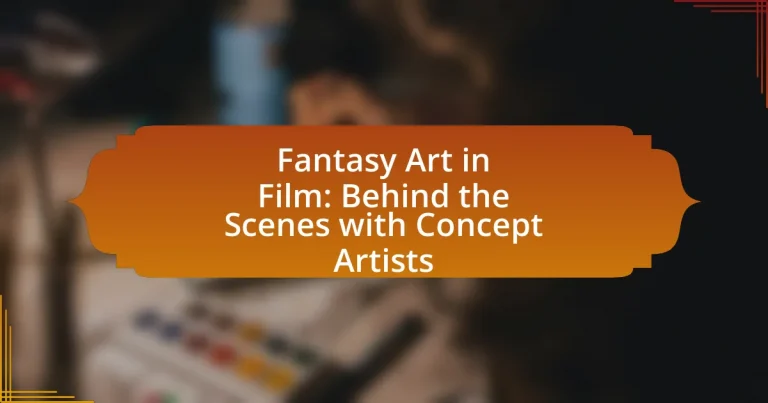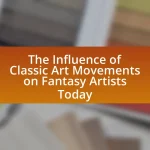Fantasy art in film encompasses the visual representation of imaginative elements that enhance storytelling, featuring fantastical creatures and surreal environments. This article explores the role of concept artists in creating these visuals, emphasizing their importance in world-building and narrative development. Key elements such as character design, color usage, and artistic techniques are discussed, along with the collaborative process between concept artists and other departments in filmmaking. Notable examples of fantasy art in films, advancements in technology, and best practices for aspiring artists are also highlighted, providing a comprehensive overview of the significance of fantasy art in the cinematic experience.
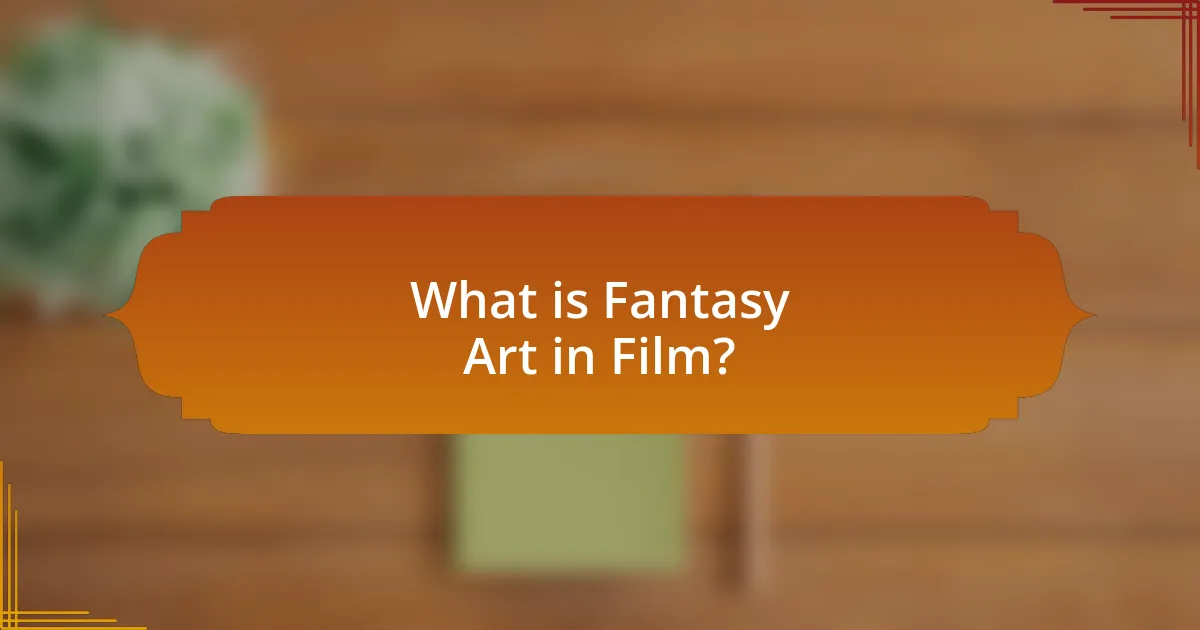
What is Fantasy Art in Film?
Fantasy art in film refers to the visual representation of imaginative and otherworldly elements that enhance storytelling in cinematic works. This genre of art often includes fantastical creatures, magical landscapes, and surreal environments, which are crucial for creating immersive worlds that captivate audiences. Concept artists play a vital role in this process by designing these visuals, often drawing inspiration from mythology, folklore, and literature, to establish the film’s aesthetic and thematic direction. The significance of fantasy art is evident in films like “The Lord of the Rings,” where detailed artwork contributed to the film’s iconic visual style and narrative depth.
How does Fantasy Art influence the storytelling in films?
Fantasy art significantly influences storytelling in films by providing a visual foundation that shapes the narrative and character development. Concept artists create detailed illustrations and designs that establish the film’s aesthetic, helping to visualize fantastical elements and settings that are crucial for immersive storytelling. For instance, films like “The Lord of the Rings” utilized fantasy art to depict Middle-earth, which not only guided the production design but also informed the emotional tone and thematic depth of the story. This visual representation allows filmmakers to communicate complex ideas and emotions, making the narrative more engaging for the audience.
What are the key elements of Fantasy Art that enhance visual narratives?
The key elements of Fantasy Art that enhance visual narratives include imaginative world-building, character design, and the use of color and light. Imaginative world-building creates immersive environments that transport viewers into fantastical realms, allowing for deeper engagement with the story. Character design establishes unique identities and traits, making characters relatable and memorable, which is crucial for emotional investment. The use of color and light sets the mood and tone, guiding the viewer’s emotional response and highlighting important narrative elements. These components work together to create a cohesive and compelling visual narrative that captivates audiences.
How does Fantasy Art contribute to world-building in cinematic universes?
Fantasy art significantly contributes to world-building in cinematic universes by visually establishing the unique settings, characters, and cultures that define these fictional worlds. Concept artists utilize fantasy art to create detailed illustrations that serve as blueprints for the film’s aesthetic, helping filmmakers and audiences alike to immerse themselves in the narrative. For instance, the intricate designs seen in films like “The Lord of the Rings” and “Avatar” originate from fantasy art, which outlines the geography, architecture, and costumes, thereby enhancing the storytelling experience. This visual foundation not only guides production design but also influences the emotional tone and thematic elements of the film, making the world more believable and engaging for viewers.
Why is Concept Art important in the filmmaking process?
Concept art is crucial in the filmmaking process as it visually communicates ideas and concepts before production begins. This early visualization helps directors, producers, and the entire creative team align on the film’s aesthetic and narrative direction. By providing a tangible representation of characters, environments, and key scenes, concept art facilitates informed decision-making and enhances collaboration among departments. For instance, films like “Avatar” and “Star Wars” utilized extensive concept art to establish their unique worlds, which ultimately guided the visual effects and production design, ensuring a cohesive final product.
What role does Concept Art play in pre-production?
Concept Art plays a crucial role in pre-production by visually communicating ideas and establishing the aesthetic direction of a film. This visual representation helps filmmakers, including directors and production designers, to conceptualize characters, environments, and key scenes before actual production begins. By creating detailed illustrations and designs, concept artists provide a reference point that guides the entire production team, ensuring a cohesive vision. For instance, films like “Avatar” utilized extensive concept art to develop the unique visual style and world-building elements, which were essential for the film’s success.
How does Concept Art facilitate communication among the creative team?
Concept Art facilitates communication among the creative team by providing a visual representation of ideas, which helps align the team’s vision and expectations. This visual medium allows artists, directors, and producers to discuss concepts more effectively, reducing misunderstandings and ensuring that everyone is on the same page regarding the project’s aesthetic and thematic direction. For instance, concept art can illustrate character designs, environments, and key scenes, serving as a reference point that guides discussions and decisions throughout the production process. This collaborative approach enhances creativity and streamlines workflow, ultimately contributing to a cohesive final product.
What skills are essential for Concept Artists in the film industry?
Essential skills for Concept Artists in the film industry include strong drawing and painting abilities, proficiency in digital art software, and a deep understanding of visual storytelling. Drawing and painting skills enable artists to create compelling visuals that convey ideas effectively. Proficiency in software like Adobe Photoshop and 3D modeling tools is crucial for producing high-quality concept art. Additionally, a solid grasp of visual storytelling helps artists communicate narratives through their designs, ensuring alignment with the film’s vision and themes. These skills are foundational for Concept Artists to succeed in the competitive film industry.
What artistic techniques do Concept Artists utilize in their work?
Concept artists utilize a variety of artistic techniques in their work, including digital painting, sketching, 3D modeling, and color theory. Digital painting allows artists to create detailed and vibrant images using software like Adobe Photoshop, which is essential for visualizing concepts quickly. Sketching serves as a foundational technique for brainstorming ideas and exploring different designs rapidly. 3D modeling, often done with programs like Blender or Maya, enables artists to create three-dimensional representations of their concepts, providing a more realistic view of how elements will appear in the final product. Additionally, understanding color theory helps concept artists effectively convey mood and atmosphere, which is crucial in fantasy art for film. These techniques collectively enhance the ability of concept artists to communicate their visions clearly and effectively within the film industry.
How do Concept Artists adapt their style to different film genres?
Concept artists adapt their style to different film genres by analyzing the thematic elements, visual aesthetics, and emotional tones specific to each genre. For instance, in fantasy films, concept artists often employ vibrant colors, whimsical designs, and imaginative creatures to evoke a sense of wonder, while in horror films, they might use darker palettes, unsettling imagery, and grotesque forms to create tension and fear. This adaptation is supported by the need to align visual concepts with the narrative and audience expectations, as seen in successful films like “The Lord of the Rings,” where the art style reflects the epic and fantastical nature of the story, contrasting sharply with the stark realism found in films like “Saving Private Ryan.”
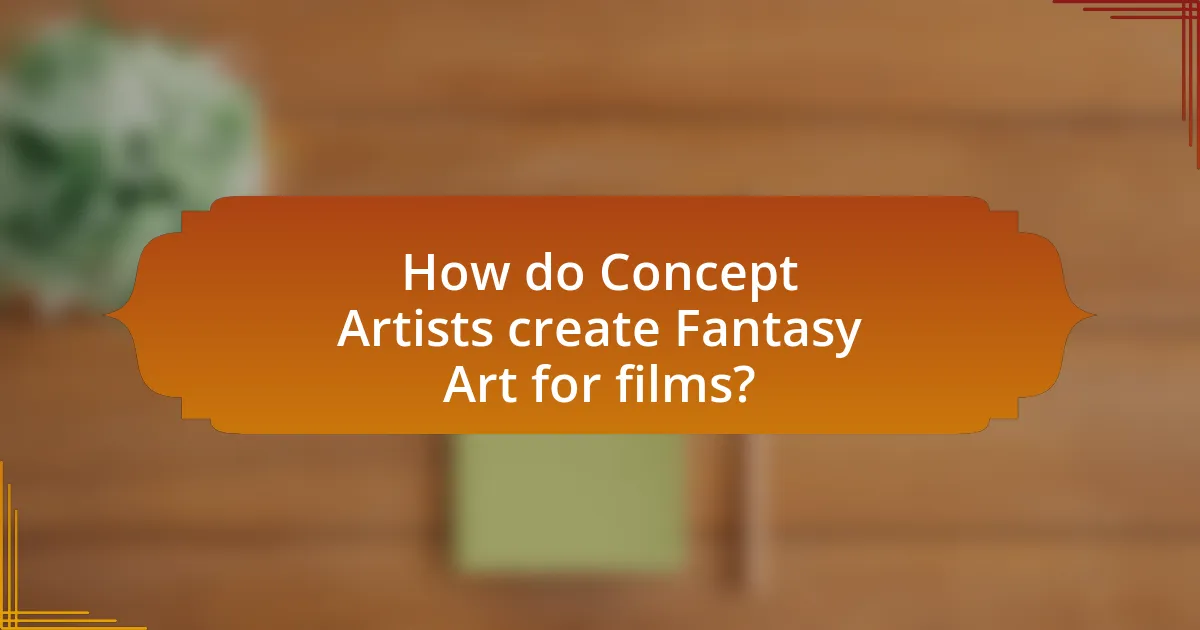
How do Concept Artists create Fantasy Art for films?
Concept artists create fantasy art for films by developing visual representations of characters, environments, and props that align with the film’s narrative and aesthetic vision. They begin by collaborating with directors and writers to understand the story and themes, followed by sketching initial concepts that explore various styles and ideas. This iterative process often involves creating detailed illustrations and digital paintings, which serve as visual guides for the production team. Concept artists utilize tools like Adobe Photoshop and 3D modeling software to refine their designs, ensuring they are feasible for production while maintaining artistic integrity. Their work is crucial in establishing the film’s visual language, as evidenced by the significant role concept art played in films like “The Lord of the Rings,” where early designs influenced the final look of the characters and settings.
What is the typical workflow for a Concept Artist in film production?
The typical workflow for a Concept Artist in film production involves several key stages: initial brainstorming, sketching, refining designs, and collaborating with other departments. Concept Artists begin by interpreting scripts and collaborating with directors and production designers to establish the visual style and themes of the film. They create rough sketches and thumbnails to explore various ideas, which are then refined into more detailed illustrations. These refined designs serve as visual references for the production team, ensuring consistency in the film’s aesthetic. Throughout the process, Concept Artists frequently collaborate with other departments, such as visual effects and costume design, to align their work with the overall vision of the film. This workflow is essential for translating narrative elements into visual concepts that guide the production.
How do Concept Artists gather inspiration for their designs?
Concept artists gather inspiration for their designs through a combination of observation, research, and personal experiences. They often study various sources such as nature, architecture, and cultural artifacts to inform their creative process. For instance, many concept artists analyze films, video games, and artwork from different genres to understand visual storytelling and design principles. Additionally, they may explore online platforms like Pinterest or ArtStation to discover trends and gather visual references. This multifaceted approach allows them to create unique and compelling designs that resonate with the themes of fantasy art in film.
What tools and software do Concept Artists commonly use?
Concept Artists commonly use digital painting software such as Adobe Photoshop, Corel Painter, and Procreate for creating illustrations. These tools provide a wide range of brushes, textures, and editing capabilities that facilitate the artistic process. Additionally, 3D modeling software like Blender and ZBrush is often utilized for creating detailed character and environment designs, allowing artists to visualize concepts in three dimensions. The use of these tools is supported by industry standards, as Adobe Photoshop has been a staple in the creative industry for decades, while Blender is recognized for its robust features and accessibility.
How do Concept Artists collaborate with directors and other departments?
Concept artists collaborate with directors and other departments by creating visual representations that align with the overall vision of the project. They engage in discussions with directors to understand thematic elements and narrative goals, ensuring that their designs reflect the intended atmosphere and character development. Additionally, concept artists work closely with departments such as production design, visual effects, and costume design to ensure consistency across all visual elements. This collaboration often involves iterative feedback sessions, where concept artists refine their work based on input from directors and other team members, facilitating a cohesive artistic direction throughout the production process.
What is the process of feedback and revisions in Concept Art creation?
The process of feedback and revisions in Concept Art creation involves multiple stages of critique and refinement to enhance the artwork’s alignment with the project’s vision. Initially, concept artists present their designs to directors or art leads, who provide constructive feedback based on the project’s requirements and aesthetic goals. This feedback often includes suggestions for adjustments in color, composition, and character design.
Following the initial critique, artists revise their work accordingly, implementing the suggested changes to improve the concept. This iterative process may involve several rounds of feedback and revisions, ensuring that the final artwork meets the expectations of the creative team. The collaborative nature of this process is crucial, as it allows for diverse perspectives to shape the final design, ultimately contributing to the overall success of the film’s visual narrative.
How do Concept Artists ensure their work aligns with the film’s vision?
Concept artists ensure their work aligns with the film’s vision by closely collaborating with directors and production designers throughout the creative process. This collaboration involves regular meetings and feedback sessions where concept artists present their designs and receive input to refine their work. Additionally, they study the film’s script, themes, and visual references to create artwork that reflects the intended tone and style. For instance, concept artists often create mood boards and color palettes that resonate with the film’s aesthetic, ensuring that their designs are cohesive with the overall vision. This methodical approach helps maintain alignment with the film’s narrative and artistic direction.
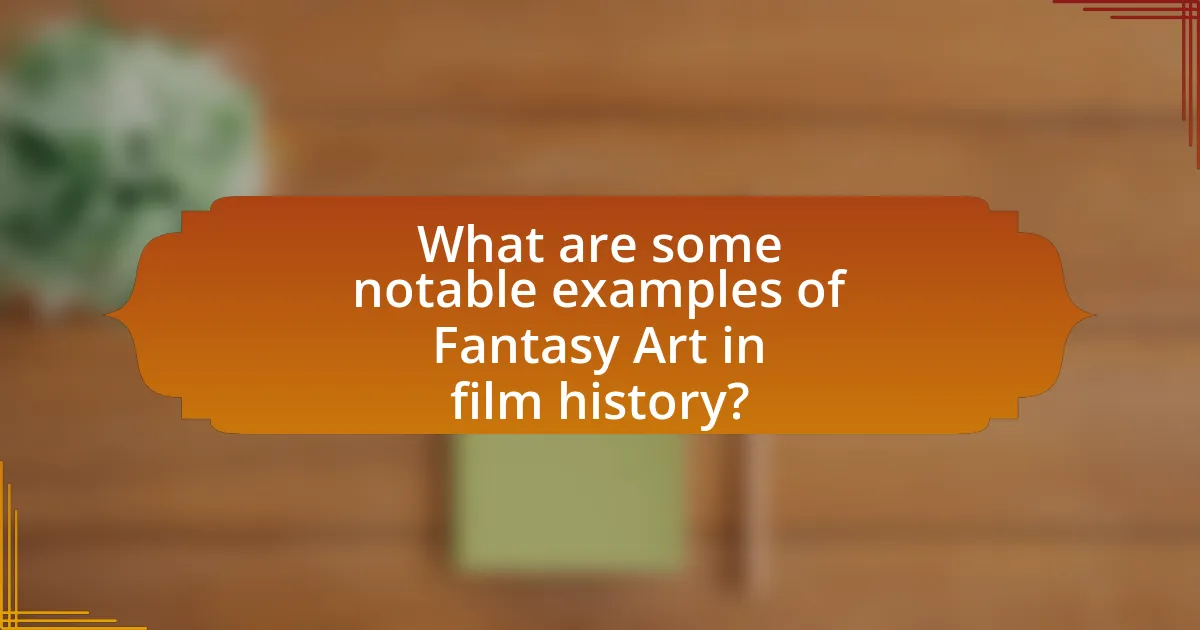
What are some notable examples of Fantasy Art in film history?
Notable examples of Fantasy Art in film history include “The Lord of the Rings” trilogy, “Pan’s Labyrinth,” and “Avatar.” “The Lord of the Rings,” directed by Peter Jackson, features concept art by Alan Lee and John Howe, which significantly shaped the visual style of Middle-earth, earning multiple Academy Awards for its art direction. “Pan’s Labyrinth,” directed by Guillermo del Toro, showcases the imaginative work of artist and designer, who created hauntingly beautiful creatures and environments that reflect the film’s dark fairy tale narrative. “Avatar,” directed by James Cameron, utilized groundbreaking visual effects and concept art by James Cameron and his team, which helped create the lush, alien world of Pandora, winning the Academy Award for Best Visual Effects. These films exemplify how fantasy art plays a crucial role in world-building and storytelling in cinema.
How has Fantasy Art evolved in major film franchises?
Fantasy art in major film franchises has evolved significantly from traditional hand-drawn illustrations to advanced digital techniques. Initially, films like “The Lord of the Rings” relied heavily on practical effects and hand-painted concept art, which set a high standard for visual storytelling. As technology progressed, franchises such as “Star Wars” and “Harry Potter” began incorporating CGI and digital painting, allowing for more intricate and expansive worlds. The use of software like Adobe Photoshop and 3D modeling tools has enabled artists to create highly detailed environments and characters, enhancing the overall cinematic experience. This shift not only reflects advancements in technology but also a growing collaboration between artists and filmmakers, leading to a more immersive and visually stunning portrayal of fantasy narratives.
What are the iconic films that showcase exceptional Fantasy Art?
Iconic films that showcase exceptional Fantasy Art include “The Lord of the Rings” trilogy, “Pan’s Labyrinth,” and “Avatar.” “The Lord of the Rings,” directed by Peter Jackson, features groundbreaking visual effects and intricate set designs that brought J.R.R. Tolkien’s world to life, earning multiple Academy Awards for its art direction. “Pan’s Labyrinth,” directed by Guillermo del Toro, is renowned for its dark, imaginative visuals that blend fantasy with historical context, receiving critical acclaim for its artistic achievements. “Avatar,” directed by James Cameron, revolutionized visual effects and world-building in cinema, showcasing a richly detailed alien ecosystem that garnered significant recognition, including Oscars for Best Art Direction and Best Visual Effects.
How have advancements in technology influenced Fantasy Art in film?
Advancements in technology have significantly influenced Fantasy Art in film by enhancing visual effects, enabling more intricate designs, and facilitating the creation of immersive worlds. The introduction of computer-generated imagery (CGI) has allowed artists to create fantastical creatures and environments that were previously impossible to realize, as seen in films like “Avatar,” which utilized advanced motion capture technology to bring characters to life. Additionally, software such as Adobe Photoshop and 3D modeling tools like Blender have revolutionized the concept art process, allowing artists to iterate quickly and visualize their ideas in greater detail. The use of virtual reality (VR) and augmented reality (AR) in pre-production has further transformed how filmmakers conceptualize and plan their projects, providing a more interactive experience for both artists and directors.
What lessons can be learned from successful Fantasy Art in films?
Successful Fantasy Art in films teaches the importance of cohesive world-building, character design, and visual storytelling. Cohesive world-building ensures that the fantasy elements are believable and immersive, as seen in films like “The Lord of the Rings,” where detailed landscapes and cultures enhance viewer engagement. Character design plays a crucial role in conveying personality and narrative, exemplified by the unique designs in “Avatar,” which reflect the characters’ traits and the film’s themes. Visual storytelling, demonstrated in “Pan’s Labyrinth,” uses art to convey emotions and plot without relying solely on dialogue, showcasing how imagery can deepen the audience’s connection to the story. These lessons highlight the necessity of integrating artistic elements to create a compelling and immersive cinematic experience.
What best practices should aspiring Concept Artists follow?
Aspiring Concept Artists should focus on developing a strong foundational skill set in drawing, painting, and digital art tools. Mastery of these skills is essential, as they form the basis for creating compelling visual concepts that communicate ideas effectively. Additionally, studying anatomy, perspective, and color theory enhances an artist’s ability to create believable and engaging designs.
Regularly seeking feedback from peers and mentors is crucial for growth, as constructive criticism helps refine artistic techniques and concepts. Building a diverse portfolio that showcases a range of styles and subjects is also important, as it demonstrates versatility and creativity to potential employers in the film industry.
Networking within the industry and participating in art communities can provide valuable opportunities for collaboration and exposure. Staying updated on industry trends and technologies ensures that aspiring artists remain relevant and competitive in a rapidly evolving field.
How can emerging artists develop their unique style in Fantasy Art?
Emerging artists can develop their unique style in Fantasy Art by experimenting with various techniques and influences while consistently practicing their craft. This involves studying the works of established fantasy artists, understanding different artistic styles, and incorporating personal experiences and interests into their artwork. For instance, artists can analyze the visual storytelling methods used in popular fantasy films and games, which often blend realism with imaginative elements, to inspire their own creations. Additionally, participating in art communities and seeking constructive feedback can help refine their style, as collaboration and critique are essential for growth.
